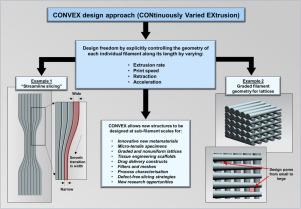Additive Manufacturing ( IF 10.3 ) Pub Date : 2020-10-05 , DOI: 10.1016/j.addma.2020.101576 Amirpasha Moetazedian , Anthony Setiadi Budisuharto , Vadim V. Silberschmidt , Andrew Gleadall

|
This study introduces a new microscale design approach, CONVEX, based on the idea of CONtinuously Varying EXtrusion widths of deposited filaments in material extrusion additive manufacturing (MEAM). The CONVEX design approach breaks free from the traditional 3D printing workflow of filling a CAD-model volume with stacked extruded filaments of constant width and height. Instead, the geometry of each filament is explicitly designed over its entire length. The concept may disrupt a wide range of applications in both the short and long term. In the least ambitious short-term implementation of CONVEX, its principles can be integrated into 3D printing slicing software to allow a geometric form to be fitted by streamlined filaments, with constantly varying widths as required to match the overall geometry (referred to as “streamlined slicing”). The use of continuous streamlined filaments, as opposed to frequently changing the number of filaments, improved the quality of manufactured parts by eradicating voids and defects, which are known to cause critical stress concentrations in specimens for tensile testing. At the other end of the scale, in the most disruptive implementation of the CONVEX design approach, entire new material structures and product types will be enabled, with feature size-scales perhaps an order of magnitude lower than that permitted by present design rules. This will enable new innovative metamaterials and is particularly appropriate for high-value applications such as advanced filtering, tissue engineering, drug delivery, microfluidics or electronics, where the geometries of individual extruded filaments (or deliberate inter-filament pores) form the functional design geometry. To prove the technical feasibility of CONVEX, this study includes rigorous experimental work to characterise how instantaneous changes to MEAM process parameters (e.g. speed, acceleration, extrusion rate and retraction) enable highly controllable and dynamic variation of the width of extruded filaments (from 75% to 250% of nozzle diameter). The concept is proven for multiple materials, layer heights, extrusion temperatures, nozzle sizes, and for both Bowden and direct-drive printer types. The Bowden printer was found to be an order of magnitude less responsive to changes in extrusion rate than the direct-drive printer. Case studies demonstrate the CONVEX design approach, which has already enabled break-through micro-mechanical research for MEAM. Industrial implications are discussed along with the potential for translation to other manufacturing processes.
中文翻译:

CONVEX(连续挤出):增材制造的新设计规模
这项研究基于在材料挤压增材制造(MEAM)中连续改变沉积长丝的挤压宽度的思想,引入了一种新的微型设计方法CONVEX。CONVEX设计方法与传统的3D打印工作流程不同,传统的3D打印工作流程是使用恒定宽度和高度的堆叠挤出丝填充CAD模型体积。相反,每根灯丝的几何形状均在其整个长度上进行了明确设计。该概念可能会在短期和长期内破坏广泛的应用程序。在最雄心勃勃的CONVEX短期实施方案中,可以将其原理集成到3D打印切片软件中,以使流线形的细丝适合几何形状,并根据需要匹配不断变化的宽度以匹配整体几何形状(称为“流线型”切片”)。与不断变化的长丝数量相反,使用连续的流线型长丝可以通过消除空隙和缺陷来提高制造零件的质量,这些空隙和缺陷已知会在用于拉伸测试的样品中引起临界应力集中。另一方面,在CONVEX设计方法的最具破坏性的实现中,将启用全新的材料结构和产品类型,特征尺寸可能比当前设计规则所允许的尺寸低一个数量级。这将启用新的创新超材料,特别适用于高价值应用,例如高级过滤,组织工程,药物输送,微流体或电子学,各个挤出长丝的几何形状(或故意的长丝间孔)形成了功能设计几何形状。为了证明CONVEX的技术可行性,这项研究包括严格的实验工作,以表征MEAM工艺参数的瞬时变化(例如速度,加速度,挤出速率和收缩)如何使挤出长丝宽度的高度可控和动态变化(从75%起)。到喷嘴直径的250%)。该概念已被证明适用于多种材料,层高,挤出温度,喷嘴尺寸以及Bowden和直接驱动打印机类型。与直接驱动打印机相比,发现鲍登打印机对挤压速度变化的响应要小一个数量级。案例研究证明了CONVEX设计方法,它已经为MEAM带来了突破性的微机械研究。讨论了工业意义以及转换为其他制造工艺的潜力。











































 京公网安备 11010802027423号
京公网安备 11010802027423号